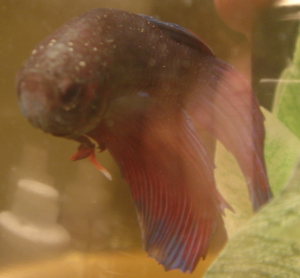brainologist
Aquarium Advice Newbie
- Joined
- Feb 29, 2008
- Messages
- 6
Hello All. Long time reader, first time post-er.
My girlfriend and I recently acquired a betta (~3wks ago) and have been keeping him in a classic fish bowl (1, 1.5gal?). Deciding this was probably a little small, and that he would look much nicer in a bigger tank, we're setting up a 10gal for him. Two days ago we noticed the little guy has white spots on his forehead, characteristic of Ich. The number of them has increased over the past day. We're preparing to treat him with "QuICK Cure" (formalin + malachite green), however I want to be sure of one thing first:
Should we treat him for Ich in the fish bowl he's in? Or should we move him into the 10-gal tank and begin treatment there?
I can see arguments both ways: Leaving him in the bowl won't give him the stress of a move or new water conditions. However, treating him in the tank might be safer, as it may be harder to regulate the concentration of medicine in the small bowl.
So I defer to the wisdom of the Internet... treat then move? Or move then treat?
Water conditions in the bowl (as determined by AP Freshwater master test kit):
pH: 7.2
Ammonia: between 0.25 - 0.5 ppm
Temp: 25 C
(We haven't begun cycling the 10 gal yet, so its water conditions are 7.2pH and all other nitrogen compounts 0ppm).
Thanks in advance!
My girlfriend and I recently acquired a betta (~3wks ago) and have been keeping him in a classic fish bowl (1, 1.5gal?). Deciding this was probably a little small, and that he would look much nicer in a bigger tank, we're setting up a 10gal for him. Two days ago we noticed the little guy has white spots on his forehead, characteristic of Ich. The number of them has increased over the past day. We're preparing to treat him with "QuICK Cure" (formalin + malachite green), however I want to be sure of one thing first:
Should we treat him for Ich in the fish bowl he's in? Or should we move him into the 10-gal tank and begin treatment there?
I can see arguments both ways: Leaving him in the bowl won't give him the stress of a move or new water conditions. However, treating him in the tank might be safer, as it may be harder to regulate the concentration of medicine in the small bowl.
So I defer to the wisdom of the Internet... treat then move? Or move then treat?
Water conditions in the bowl (as determined by AP Freshwater master test kit):
pH: 7.2
Ammonia: between 0.25 - 0.5 ppm
Temp: 25 C
(We haven't begun cycling the 10 gal yet, so its water conditions are 7.2pH and all other nitrogen compounts 0ppm).
Thanks in advance!

